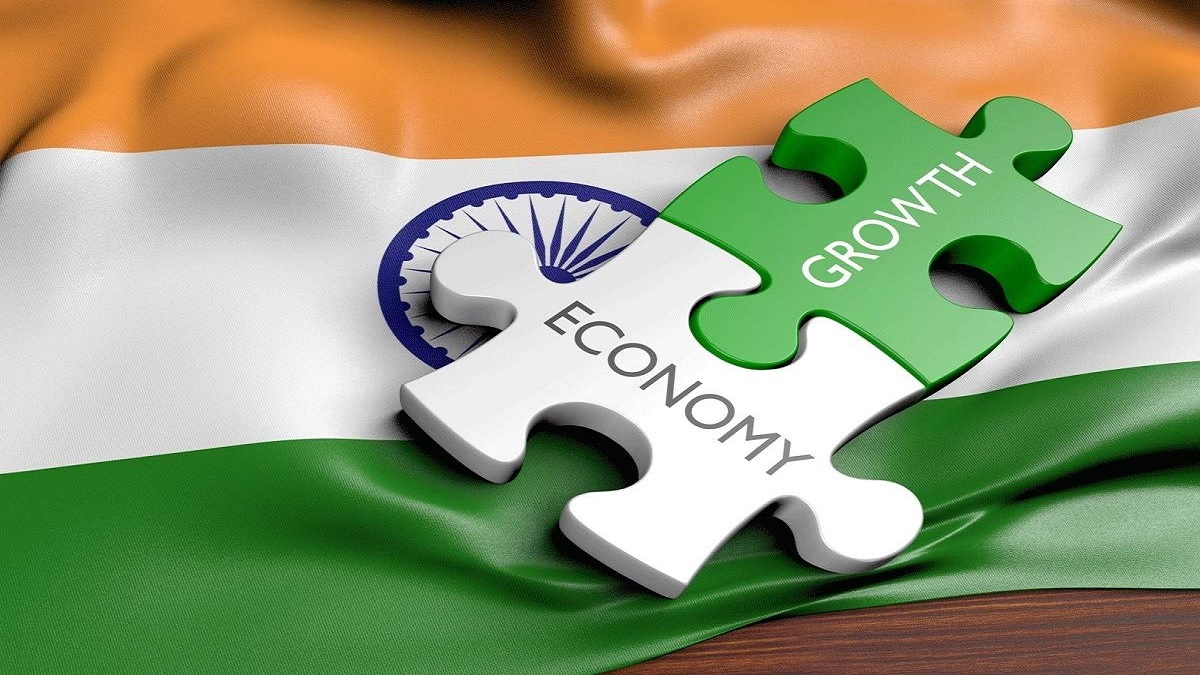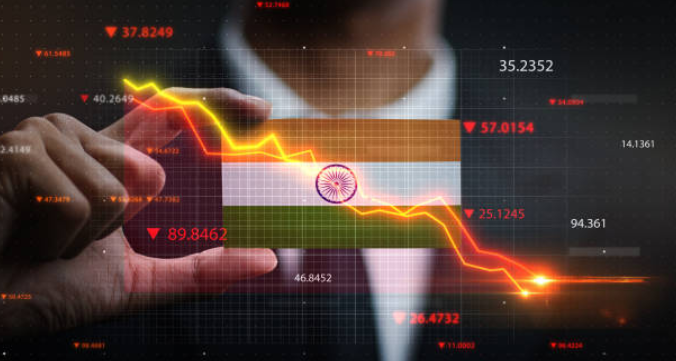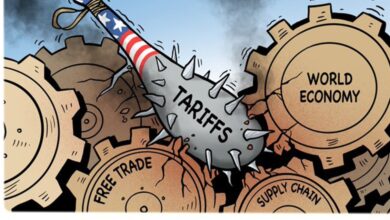How’s the world’s new 5th largest economy doing?

According to data from the fourth quarter of 2021, the Indian economy was larger than that of the United Kingdom. The computation uses the most recent rates for the US dollar, the British pound, and the Indian rupee separately. The economic statistics were provided by the International Monetary Fund.
India now ranks fifth globally in terms of economy, trailing only China, Japan, the United States, and Germany. According to the same data, India’s Economy currently stands at $3.2 trillion, falling short of Germany’s $4.2 trillion.
Per data from the World Bank, the UK had a population of 67.3 million in 2022. India had a population of 1.39 billion people. India’s economy (at current prices) was $3.18 trillion in 2022, according to IMF statistics. In contrast, the UK’s economy was £3.19 trillion. Only 67.3 million Britons engaged in almost as much significant, productive labor as did 1.39 billion Indians. In other words, while Indian thrift did reach that of the UK in 2022, an Indian’s output or average income remains well below that of a British one.
If India expands at a 7% yearly rate, Germany will be surpassed by India four times over. It will take five times as much if the growth rate is five years. If you believe that German austerity will preclude any growth, there is a catch. Exchange rates for currencies provide a challenge. It will be more difficult to overtake Germany soon if the rupee-dollar exchange rates drop more quickly than the euro-dollar rates.
According to IMF data, the per capita or average income of a British person was$2,203 in 2022. Indians made$283 on average, which is lower than five times what the average British person makes. Indeed, even if Indian GDP may have overhauled that of the UK and France many times over, the ordinary Indian’s payment is still pitifully low when compared to that of these nations.
This has to be mentioned along with the fact that India’s GDP is presently the fifth largest in the world. The benefits of the economic growth gap are kindly neutralized by the currency’s deprecation. India’s economy will expand more snappily in terms of its currency earnings strength against
A strong currency still, couldn’t be good for India’s exports, which would be mischievous. Likewise, industrialized nations have had harmonious and profitable development for more than a century, which enabled them to help their impoverished people escape poverty. As a result, they have far superior social and financial standards than India. This must also be honored. What rank does India now hold in terms of per capita income? In 2021, India was rated 145th out of 193 nations for which data was available. While Kenya was taken over, the Solomon islets were deposited below.
If worldwide comparisons are susceptible to exchange rates, the World Bank has created a new metric called “copping power equality.” It adjusts exchange rates to match the “actual” purchasing power of the vibrant currencies.
In reality, one in India is worth far more than one in the United States. At least five times, India’s economy arose to third in the world after this adaptation, where it has remained for at least five times. In an analogous tone, China’s economy was formerly larger than America’s in PPP terms. And the two Asian titans will rule the profitable geography of the twenty-first century as a result of their rapid-fire rates of development and enormous populations.
From a demographic standpoint, this has been fully acknowledged at least 20 times, and it is inevitable. Investors are undoubtedly scrutinizing these two key consumer husbandry metrics (never mind the arising tech cold war between the West and China). When comparing incomes, one should take into account the equal purchasing power of people in neighboring countries. By accepting power equality, affectation, or the pace of price increase, as it is experienced in diverse nations, is accommodated for.
India ranked third encyclopedically in terms of GDP measured in terms of buying power in 2021, behind China and the US. The UK ranked ninth. Unfeigned, I am curious as to why this hasn’t received less attention on social media yet. India will ultimately reach the fabulous$ 5 trillion GDP size, so it does not count where it comes in the rankings or how soon it does so. India’s GDP has grown by 7 annually for the last 40 years (excluding the epidemic times), and other than in 2020–21, there has never been a time of compression (i.e., negative GDP growth). Similar is the muscle of India’s development.
This entails fastening on the near future and assessing the liability of product expansion, employment growth, affectation operations, and the viability of the financial and trade poverties. When questioned about its GDP, we may refer to data criteria that are constantly cited. Some are daily, like stock request updates, while others are yearly, like the significance of exports or the artificial affair indicator.
The National Statistics Office estimated India’s GDP for the quarter of April to June at Rs 36.85 lakh crore last week. This is the actual GDP after accounting for the effect of affectation. This number is 13.5 percentage points greater than the actual GDP for the April–June quarter of last year. The expansion was happening so quickly that it made a jubilant sound that called for capping. We must, however, consider this material in its proper perspective.
We saw a terrible second wave of COVID last year that expanded to rural regions, caused severe suffering, and resulted in several fatalities.
An English person’s average income in 2021 was $50,388; an Indian’s average income, when adjusted for purchasing power parity, was $7,341. In light of purchasing power, the situation, therefore, appears to be slightly better, although the discrepancy is still substantial.
What is India’s current standing in terms of per capita income that has been adjusted for purchasing power parity? India was ranked 128th out of 193 nations. The UK was ranked 27th. So, when we compare things in terms of buying power parity, the difference between India and the UK does narrow. However, there is still a sizable disparity.
However, looking at data from 2021 shows the situation at a certain point rather than across time. To narrow this gap, we must look at data throughout time. Let’s start by looking at where the Indian economy was in proportion to the country’s total size starting in 1981. Lockdowns and restrictions hampered business. As a result, even if experts had predicted a higher figure, 13.5 percent seems reasonable given the low starting point.
Compare GDP numbers for the months of April through June of 2019 without taking into consideration the impact of the previous two pandemic-affected years. This amounted to Rs 35.67 lakh core, or less than 1.1% yearly, or a quarterly GDP growth rate of just 3.3% during the previous three years. This concerns me. The obvious necessity for financial growth has had a substantial impact on this slowly evolving situation.
Analyzing the statistics in terms of momentum, or how quickly the GDP is growing from quarter to quarter, is another method. The data in this case also doesn’t seem encouraging. According to a Barclays analysis, there was negative growth, or a contraction of 3.3%, in the quarter-over-quarter increase from January-March to April-June. Of course, seasonal influences could contribute to some of this as well.
Over the years, the overall number of nations on the list has changed. The reason for this is that new countries are emerging and certain countries do not always have statistics readily available. Take Afghanistan as an example, which has historically been at war with it. The availability of data for the country has been quite low over the decades. A cursory perusal of the preceding table could lead one to believe that between 2011 and 2022, when the worldwide rank rose from tenth to fifth, India’s standing significantly improved.
However, it’s important to note that the majority of the growth that gave India’s ranking a chance to rise during the last 10 years occurred between 2001 and 2011. Additionally, industrialized nations like the UK struggled with economic development between 2011 and 2021. Over the past ten years, the UK has grown by 1.8% annually. In India, in contrast, GDP increased at a rate of 5.7% per year during the last ten years. In the ten years before that, it increased by 13.9% annually (2001-2011). Keep in mind that these are nominal values that are not inflation-adjusted.
Even after accounting for inflation, growth between 2001 and 2011 was greater than growth between 2011 and 2021. Of course, demonetization, the poorly executed introduction of the goods and services tax, and the expansion of the COVID epidemic are the main causes of this.
This stands in stark contrast to the slowdown in China and the recession in both America and Europe. The state of the world has an impact on India. The Reserve Bank of India is worried that India may soon see rising inflation and a deteriorating economy.
According to the RBI’s forecast, the final quarter of this fiscal year will see 4% growth. Additionally, the rate-tightening monetary policy slows GDP further but is necessary given inflation. The stock markets are also reflecting the mood and preparing for a drop.
The fifth biggest economy is thus anticipated to suffer as a result of the need for increased economic drivers and investor confidence. The continuously high GST collection (above Rs 1.4 lakh crore for four consecutive months) and the double-digit growth in the industrial output index for May and June are two encouraging signals. According to August data, even bank loan growth was at its best in 11 years, exceeding bank deposits. This is equally true for retail and mortgage loans. As a result, there are always grounds for cautious optimism in the medium term.
Here, two points must be made. First, those who enjoy contrasting the economies of India and Bangladesh arrived extremely late. Since 1991, the show has been airing. Second, it is commonly known that the economies of China and India were practically competitive before 1991, but it is less well recognized that Bangladesh’s economy was competitive with China at the time. And those are some statistics (although I’m still not sure how the per-capita income in Pakistan was so much higher than that of China).
India’s ranking arose from 154 in 2011 to 145 in 2021. However, as can also be shown, the average Indian income increased far higher between 2001 and 2011, which put us in a position to move up the rankings after growth in many industrialized nations halted after 2011. This explains how the state of the economy at one point, whether it’s good or bad, affects the subsequent period under consideration. Therefore, analyzing only once and concluding is not the proper course of action.
As a result, markets became more unpredictable, and global yields progressively soared. Concern was also allayed by the RBI’s comments about inflation having peaked. Improvement was seen in domestic development indicators, including the PMI print, credit demand, GST, electronic imports, and toll revenues. The poll finds that India’s manufacturing and services PMI for August shows continued activity momentum supported by strong demand and lessening pricing pressures.
Additionally, the South-West monsoon has made good progress, and reservoir storage levels are sufficient. However, the Kharif sowing has been hampered and is 13.7% lower than the previous year due to various regions of eastern and northern India receiving insufficient precipitation. Lower rice and pulse sowing has been the main cause of this.
The government reported a surplus of Rs 11,040 crore in July, helped by a decline in total spending and brisk income growth. As a result, the budget deficit decreased from 6.6% of GDP in FY23 to 6.3% of GDP as of July 2022. The overall increase in expenditures fell to 12.2% in FYTD23 from 15.4% in the previous year.
A dramatic drop in revenue expenditure was the driving force behind this. On the other hand, Capex is still going strong. The government’s gross tax revenues increased by 24.9% in FYTD23, up from the 22% growth recorded, driven by an increase in direct tax collections. This was another encouraging development. The amount of indirect taxes collected was largely steady. In addition, the center’s net sales increased significantly by 12.9%, up from 5% in FY23. We anticipate that the center will achieve its budget deficit goal for this year.
The Fed Chair’s hawkish comments, which predicted a trajectory for rapid rate rises, were the cause of this. It was rare for the 10-year yield in India last month to decrease by 13 basis points. Falling crude prices aided in its promotion. Rates were also calmed by central bank officials’ claims that inflation had peaked and would probably fall in the coming months.
In reality, the INR momentarily crossed the 80-to-dollar threshold before correcting, helped by the vigorous intervention of the RBI. However, the prognosis for the INR remains bleak due to escalating external headwinds in the form of a higher currency and slowing export momentum. In addition, increased US interest rates might trigger a new wave of FPI outflows from India, which would again weigh on the INR. On the other hand, as rising rates push the world economy into a slowdown, if not recession, on the plus side, oil prices may see some adjustment, analysts said, adding that generally, the rupee is anticipated to trade in the Rs 79.75–80 per dollar area in the short future.
edited and proofread by nikita sharma





